This game was released in the waning days of the Super Famicom. There are still a few well remembered RPGs after this, but Playstation and Saturn were starting to pick up steam, and once Final Fantasy VII was released at the beginning of 1997, that was basically the end for the system. After this game, my list is all Playstation and Saturn until 1999 (except for a couple of PC-FX games that may not qualify as SRPGs). Because of the late release I think this game was not given a lot of notice, as we can perhaps see from the prices of used copies of the game.
Energy Breaker was developed by Neverland Company, which is known to Western gamers primarily through the Lufia and Rune Factory series. On the whole, the game is weighted towards the RPG end of the scale. The battles are small, with at most 5 player characters. The towns and dungeons may be explored, and a good deal of the game is in walking around the various places. However, there are fixed battles (numbered) so it does qualify as an SRPG under my definition, though just barely.
The game begins with no real backstory — the main character, Maira, wakes up out of a dream where she sees a woman named Selphie talking to her. It seems that Maira has lost her memory, although exactly what she’s doing in the town isn’t explained (maybe it’s in the instruction manual). Her friend Irene tells her about a fortune teller in town who predicts everything perfectly. It turns out to be Selphie, who gives Maira a green gem. Maira’s goal seems to be to find out who she is, and she heads to a nearby forest to track down a researcher named Lenardo who is looking for companions to find a flower that can supposedly recall the dead to life.
This is just the beginning of the story, which overall is fairly decent for the time. The characters (including the villain characters) are all developed and have interesting connections to each other and the main characters. There is enough dialogue to flesh everything out. Since there’s an English patch I don’t want to say too much about the story (even though I know that many readers will never play the game, so I probably should do the whole story…I guess you can watch a youtube playthrough.)
As you explore the towns and dungeons, you can hit A on almost everything to generate a response from Maira. There are a lot of hidden treasures, although the inventory space is fairly limited (for game balance reasons, I think). Everything is done in a 3/4 view like Tactics Ogre and such, with the battles taking place on the same maps as the exploration. You can jump up places by holding a button. There are a lot of hidden passages also and chests/treasures hidden in places of the map you can’t see, so the game rewards poking around everywhere.
When you talk to people, most of them just give you a short line. But some have more options; you can give them things, or take different attitudes with them, or ask them about specific things. Only a few characters have specific things that you can ask them about. The attitude has no real effect on the game; I was barely able to find any places where it even made a difference to what the people said, much less having an effect on the plot.
The world map is a Mode-7 area where you just choose your destination. However, there are other world maps beyond the one you first see. The world is kind of semi-fantasy, semi-steampunk, with trains and robots and such.
In the non-town areas, entering a screen will sometimes produce a battle (though it doesn’t always happen until you’re partway through the screen). The first time you encounter the battle you have to fight it. If you return and activate the battle again, you can fight it again or you can choose “run away” and skip it, which is much appreciated. Each battle has a turn limit; most of the time that’s the loss condition but in some cases you win by surviving that number of turns.
The battle system resembles Tactics Ogre in that it has both height and facing. An attack from the front deals the least damage and the opponent will counter. A side attack deals the same amount but no counter, and a back attack deals the most. I am not completely certain how the mechanics work, but you will notice that when you attack, a damage number will appear, and then roll up or down (sometimes severely — like 28 down to 2). This has to do with Dexterity, and I believe it’s the difference between the attacker and defender’s DEX stats. So don’t neglect DEX.
Each turn, a character can take as many actions as they have Balance points. Each character has a set maximum Balance that will never change through the game (except for one unique item that increases it by +1). Each ability costs a certain amount of balance — moving costs 5, a basic attack is 3, using an item is 1, and abilities cost from 3-10 depending on their power. There are no other MP/AP costs or anything like that. Any ability can be used as many times as you need to in each battle as long as you have the balance. The 1 cost for items does unbalance the game a bit (no pun intended) but the limited inventory space keeps it from getting too ridiculous, as does the fact that the shopkeeper inventories for the more powerful items are limited and only refill a few fixed times during the game.
At the beginning of a turn, a character recovers some of their balance points depending on their remaining HP. The lower the HP, the less balance they recover. This sucks for your guys who sometimes have such low balance they can’t even move, but the enemies can also be reduced to low enough balance that they can’t use their attacks. This system does provide a lot of flexibility in what you do on each turn, and there’s a tension in deciding what you want to spend your balance points on for each round. If a character is defeated in battle, they just exit that battle and will return afterwards (you recover all HP at the end of each battle).
Each character learns abilities by assigning points to four elements (wind, water, earth, fire), both to “light” and “dark” sides. At first I thought you would have to choose between them, but you can assign points to both. There’s both a maximum (from 0-7) and the points you actually have assigned. By the end of the game at least some of your characters will have enough points to max out all 8 areas and assign most of the points. You learn new abilities by assigning points to the right places then taking an action in battle, upon which the character will use it and then you have it (as long as you keep the points assigned). You can figure out where to assign the points by finding certain books in the game that tell you, but there are also some hidden abilities.
The one exception to this learning method is Staa, who has to defeat certain enemies to learn attacks (in addition to having the right elements set). This is rather annoying because he tends to lag behind since there’s no indication of which enemies give you which skills. But there’s also an item Fortune Slip that can teach him abilities without having to beat the enemies (if you have the points assigned).
Not every character can learn every ability, so each character remains individual. The stat buffs are important, and probably the most crucial ability is Poison Drop, which lowers all stats of the target. This is a brutal attack when it’s directed against your own guys, but also works very well against strong
enemies. You can buy or find scrolls for many of the spells and use those instead.
In most battles you also have a robot who cannot attack or be attacked, and has 5 balance a turn (enough for one move). So you can use him to block the way for enemies, but I rarely found this helpful.
The graphics are well done; typical late Super Famicom style. The BGM is also strong, with several memorable and atmospheric tunes.
There are some flaws in the game. Parts of the story are undeveloped (supposedly the development time was cut short). Items are perhaps a bit too powerful, and the inventory limit and shop limit doesn’t entirely compensate for that. A few places in the game don’t have many hints to figure out where to go next. But all in all this is an impressive late-SFC game that’s definitely one of the better games I’ve played so far on this blog. Give it a try, if you like SRPGs that are closer to the RPG end of the scale rather than large scale army vs army games.
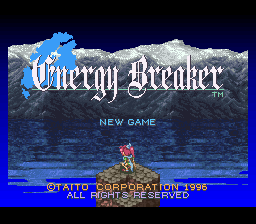

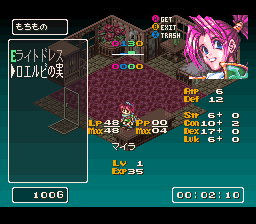
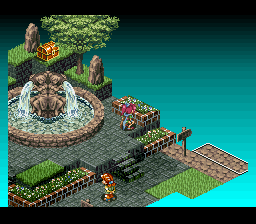

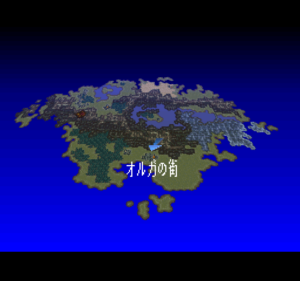
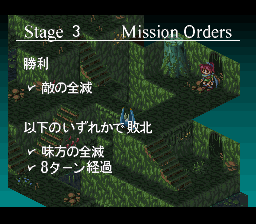
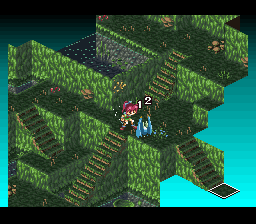
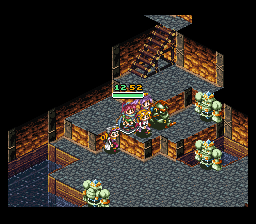
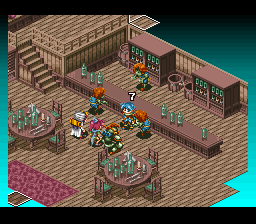
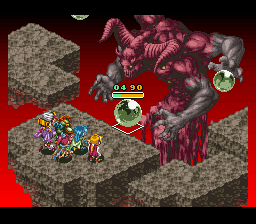
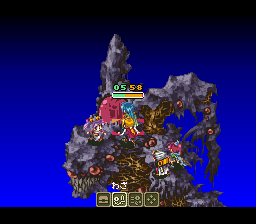
Only one post? Sounds like a really short game.
It took me 23 hours so it's not that short. I tend to only post detailed stage-by-stage things if the game involves a lot of interesting per-stage setups and strategies. There were a few stages in EB that I could have gone into detail on, but most of them involve similar strategies and are mostly just collections of generic monsters.
How difficult are the battles? Been wanting to play this for a few years now but there was never really any information about it online.
Mostly they're not too bad, but there are a few tricky ones. The key is making good use of items, and the buff/debuff spells (particularly Poison Drop).